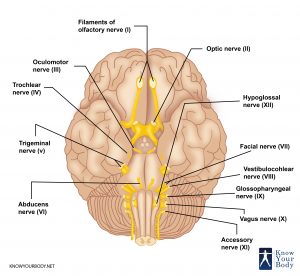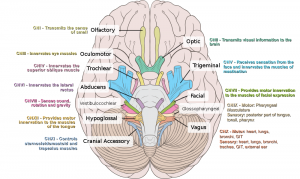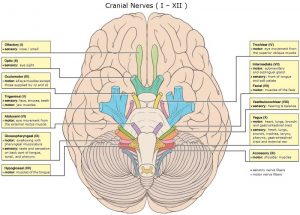What are Cranial Nerves?
Nerves which originate from the brain or the brainstem are referred to as the cranial nerves. Do keep in mind that nerves which originate from the spinal cord segments aren’t called cranial nerves.
What are the 12 Cranial Nerves?
With us knowing there are 12 pairs of cranial nerves, let’s get through which nerves are these and what are they called:
- Olfactory Nerve
- Optic Nerve
- Oculomotor Nerve
- Trochlear Nerve
- Trigeminal Nerve
- Abducens Nerve
- Facial Nerve
- Vestibulocochlear Nerve
- Glossopharyngeal Nerve
- Vagus Nerve
- Accessory Nerve
- Hypoglossal Nerve
These above listed are the 12 pairs of cranial nerves found in each and every human being.
Characteristics Of Cranial Nerves
The characteristics of this nerve are presented in the table.
| CRANIAL NERVE | NERVE TYPE | FUNCTIONS |
|---|---|---|
| 1. Olfactory Nerve | Sensory | Smell |
| 2. Optic Nerve | Sensory | Vision |
| 3. Oculomotor Nerve | Motor | Eye Movement |
| 4. Trochlear Nerve | Motor | Eyeball Movement |
| 5. Trigeminal Nerve - Ophthalmic Branch | Sensory | Facial Muscle Movement, Chewing, Sense Temperature, touch and Pain on the Face |
| 5. Trigeminal Nerve - Maxillary Branch | Sensory | Same as Above |
| 5. Trigeminal Nerve - Mandibular Branch | Mixed | Same as Above |
| 6. Abducens Nerve | Motor | Eyeball Movement |
| 7. Facial Nerve | Mixed | Sense of Taste, Saliva and Tear Secretion, Movement of Facial Muscles |
| 8. Vestibulocochlear Nerve - Cochlear (Auditory Nerve) | Sensory | Hearing |
| 8. Vestibulocochlear Nerve - Vestibular | Sensory | Maintaining the Equilibrium of the Body |
| 9. Glossopharyngeal Nerve | Mixed | Swallowing and Secretion of Saliva, Monitors Blood Pressure, Levels of Oxygen and Carbon Dioxide in Blood |
| 10. Vagus Nerve | Mixed | Parasympathetic Sensation, Control of Smooth Muscles of Lungs, Heart, Viscera and Secretion of Digestive Enzymes |
| 11. Accessory Nerve | Motor | Swallowing and Movement of Head & Shoulders |
| 12. Hypoglossal Nerve | Motor | Tongue Movement, Speech and Swallowing |
Location of the Cranial Nerves
The major function of Cranial nerves is to send and receive information from the brain to the various body parts. They operate in the head and neck region of the body.
Cranial Nerves History
Way back, during 200 AD, a roman anatomist Galen suggested the world with seven pairs of nerves. But much later, the theory of seven nerves was contradicted by Sir Thomas Willis, an English anatomist. He named the 9 pairs of cranial nerves which are present in a human being. Yet again the theory was challenged by German anatomist Samuel Soemmering who gave the 12 pairs of nerves which till date accepted by the world.
Innervation of the Cranial Nerves
The innervations of these cranial nerves are as follows.
- CN III deals with the innervation of eye muscles
- CN V is all about the motor innervations as in the Masticating Muscles (chew), Tensor Tympani Muscles (ear drum), Tensor Veli palatini muscle (palate elevation), Mylohyoid muscle (moves hyoid bone) and the Anterior belly of the digastric muscle. Plus, Cranial Nerve 5 is associated with the Sensory innervation to parts like Face, Scalp to vertex of head, Conjunctiva of the eye (covering of eye), Nasal sinus mucosal lining, Lining of oral cavity, Tongue, Teeth, External aspect of tympanic membrane, Meninges of the anterior and middle cranial fossa.
- Cranial Nerve 7 is responsible for the Motor innervation to Stapedius muscle, the Posterior belly of the digastric muscle, Muscles of facial expression and other nose, salivary and eye-related glands and other ear canals and taste buds.
- Cranial Nerve 9 innervates largely with the sinus related area.
- Cranial Nerve 10 deals with the Motor innervation to the muscles of the throat, tongue, larynx, tensor veli palatini, and abdominal organs while Cranial Nerve 12 takes care of the tongue muscles.
Blood Supply to the Cranial Nerves
The vital part of the intracavernous branches must be noted when considering the blood supply of the cranial nerves. Moreover, this stresses the need to minimize postoperative issues.
Cranial Nerves Functions And Divisions
Olfactory nerve
This nerve is related to the sense of smell. The receptors of this nerve are present in the mucosa of the nasal cavity and the sensory fibers of the nerve pass through the olfactory bulb. The olfactory nerve is the shortest nerve in the body and it does not enter the brain stem.
Optic nerve
Suggested by the name, the nerve is attached to the vision. The nerve takes the input from the retina and transmits the visual signals to the brain. The nerve is the part of the central nervous system and any damage to it may result in the complete loss of vision that too permanently.
Oculomotor nerve
The major function of this nerve is to move the eyeball and eyelid and adjust the eye lens accordingly for the need. Also, the nerve helps in the adjustment of the pupil, which governs the entering of the light through the eye. The nerve originates from the midbrain section.
Trochlear nerve
This is the third nerve which is related to the movement of eyes. This nerve also helps in the movement of the eyeballs. This nerve latter joins to the oculomotor, thus expanding the functionality of that nerve.
Trigeminal nerve
This nerve is known to the largest cranial nerve in the body. The nerve, in fact, is split into 3 branches, namely:
- Ophthalmic
- Maxillary
- Mandibular
This nerve altogether helps in facial muscle movement including chewing and also has the function to sense temperature and pain on the face.
Abducens nerve
With the functionality of moving the eyeballs outwards, this nerve originates from the medulla to the medial section of the face. It sends impulses to lateral rectus muscles to perform the designated function.
Facial nerve
Other facial expressions and sense of taste secretion of tears and saliva are associated with this cranial nerve.
Vestibulocochlear nerve
This nerve has 2 branches:
- Vestibular
- Cochlear
The vestibular nerve is associated with maintaining the equilibrium or the balance of the body by sending signals of posture and movement to the brain.
Cochlear nerve has the ability to hear and sending that impulse to the brain. Hence taking up the name hearing nerve.
Glossopharyngeal nerve
This nerve again branches into 2 nerves
- Motor nerves– These nerves help in swallowing and secretion of saliva.
- Sensory fibers– Monitors blood pressure, levels of oxygen and carbon dioxide in the blood.
Vagus nerve
This nerve is associated with the contraction and relaxation of smooth muscles. Also has the functionality to stimulate with swallowing, coughing etc. It also monitors temperature and pain sensation in the throat and abdomen area.
Accessory nerve
This nerve originates from 2 parts, cranial part (brain) and spinal part. The cranial root helps in the movement of swallowing and the spinal root helps in the movement of head and shoulders.
Hypoglossal nerve
This nerve terminates in the tongue and hence associated with the movement of the tongue. Speech and swallowing movements are some of the function of this nerve.
Cranial Nerves Pictures
Associated Conditions
The possible conditions associated with the cranial nerves are as follows:
- Abducens Nerve Diseases – Also known as sixth cranial disorders, this palsy kind of disease results in diabetics, mostly. This condition is a part of Mononeuritis Multiplex, which may result in ischemia, hypertension (sometimes), or compression of the nerve by lesions in the cavernous sinus (eg, nasopharyngeal tumors), orbit, or base of the skull.
- Accessory Nerve Diseases Of Cranial Nerves – Weakness in these muscles may result to a general disease process such as amyotrophic lateral sclerosis, Guillain-Barre syndrome or poliomyelitis. Injuries in these nerves can result in neck dissection and lymph node excision.
- Glossopharyngeal Nerve Diseases – Glossopharyngeal neuralgia is a state wherein one can experience unbearable, frequent pain in the throat, ears, tongue, and tonsils. However, this pain can stay around a few minutes.
- Cranial Nerve Injuries – These are commonly traumatic injuries.
- Cranial Nerve Malignant Neoplasm – Malignant cranial nerve sheath tumors are uncommon and deals with weak prognosis as those of spinal nerves at other places.
- Facial Nerve Diseases – This conditions pull down your facial expressions and cause weakness on your face. Bell’s palsy, Ramsay Hunt syndrome, Lyme disease are the conditions associated with facial nerve disorders.
- Hypoglossal Nerve Diseases – This condition results in tight oral musculature, making it difficult for the person to chew or eat.
- Ocular Motility Disorders – This causes impairment of eye movements.
- Olfactory Nerve Diseases – This is a result of a physical blockage in the nose and this can cause loss of smell.
- Optic Nerve Diseases – These disorders are related to loss of vision.
- Trochlear Nerve Diseases – Injuries in the nucleus of the midbrain can be counted within this.
- Vagus Nerve Diseases – These are caused by the damage of stomach muscles.
- Vestibulocochlear Nerve Diseases – Disorders related to this affects the inner ear and weaken the functions related to it.
Cranial Nerves FAQs
Why are the cranial nerves not included into the central nervous system of the body?
Answer – Apart from the first 2 nerves, all the nerves originate from the brain and form the part of the peripheral nervous system. Since they originate from the brain they do not form the part of the central nervous system.
How many cranial nerves are associated with the sense of sight?
Answer – There 4 cranial nerves associated with the sense of sight being: optic, oculomotor, trochlear and Abducens nerves.
Which cranial nerves are affected by glaucoma?
Answer – Only the optic nerve is affected by glaucoma.
How long does it take cranial nerves to heal?
Answer – Cranial nerves being one of the most important nerves of the body, can take unknown time to heal. The healing time depends on the extent of damage done to it.
Forming the most important part of the body, these nerves help with the minute details of the life. These nerves if damaged can bring a permanent damage to the lifestyle. With all the vital functions of the nerves specified, we can see that if any harm comes to them, you either lose the sensation of pain or temperature on your face or lose sight.




No comments yet.